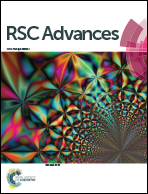A thermo-responsive dual-crosslinked hydrogel with ultrahigh mechanical strength†
Abstract
A tough poly(N-isopropylacrylamide-co-acrylic acid) (P(NIPAM-co-AA)) hydrogel has been engineered by a hybrid covalently cross-linked P(NIPAM-co-AA) and an ionic (COO)3Fe(III) coordinated network. The tough dual crosslinked hydrogel exhibited ∼6 MPa of tensile strength, 69.8 MPa of compressive strength and 330% of elongation at break. The temperature sensitive swelling behavior depended significantly on the hydrogel architecture.


 Please wait while we load your content...
Please wait while we load your content...